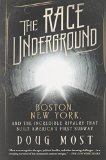Summary | Excerpt | Reviews | Beyond the Book | Readalikes | Genres & Themes | Author Bio
Boston, New York, and the Incredible Rivalry That Built America's First Subway
by Doug Most

Critics' Opinion:
Readers' Opinion:
First Published:
Feb 2014, 352 pages
Paperback:
Feb 2015, 432 pages
 Book Reviewed by:
Book Reviewed by:
BookBrowse First Impression Reviewers
Buy This Book
Excerpt
The Race Underground
On November 3, 1849, Alfred Beach could see clear down to the Hudson River from his top-floor office in downtown New York. That morning, Scientific American had published an article he wrote suggesting just about the craziest idea that New Yorkers had ever heard. It would be laughed at, mocked, and, ultimately, ignored. Nobody took it seriously in the days and weeks after it appeared, except for the young man who wrote it.
Looking out from his window at the corner of Fulton and Nassau streets in one of the city's tallest buildings, Beach could look up and see the next tall building being built, or he could look out to the water and see the parade of boats floating past in the New York harbor. The waters used to be filled mostly with tugboats, fishing boats, sloops, and the occasional mammoth steamship pulling in from Europe after the long crossing. But more recently, Beach was seeing a new type of boat dominate the harbor: Ferry boats, operated by more than twenty competing lines, were whisking an increasing tide of passengers out of Manhattan and taking them to the nearby shores of New Jersey, Staten Island, or Brooklyn. The suburbs were calling, luring city residents with open land, affordable rents, and a peacefulness that made New York feel increasingly less appealing. But there was also another, more troubling, reason that the big city no longer held the allure it once did.
On the chopped-up streets, garbage and debris were mixing with the perfume of horse-drawn carriages and piles of dung to create an odor that was almost unbearable to breathe in. And the packed sidewalks and overcrowded streets were grinding New York to an angry standstill. On some mornings, the carriages would be forced to stand motionless for half an hour or longer. When they finally moved at all, it was inches or feet at a time. One horse would lurch forward, then another, and just when it seemed as if the congestion was about to ease, it wouldn't. All day long, drivers jostled with other drivers, whipping their own horses or the one next to them, competing for passengers. The horses didn't like it any more than the well-dressed passengers inside the carriages they were pulling. The animals neighed at each other and sometimes raised up their front legs, causing fear and pandemonium. Pedestrians who tried to cross the street knew the risk they were taking carried deadly consequences with one misstep.
"We can travel from New York half-way to Philadelphia in less time than the length of Broadway," The New York Tribune wrote. Beach didn't see a problem in this clutter. From high above the city streets, he saw opportunity.
In 1849, Beach, by now sporting the skinny mustache that would be- come his trademark feature, lived a walkable distance from his office. And yet dodging the horses, the carriages, and the throngs of people each day turned his short walk from his office near City Hall to his house over on West Twentieth Street into a treacherous hour-long commute. After three years of listening to a parade of inventors promote their dreams to him, Beach decided it was time to share his own dream for his city, in an essay he published in Scientific American.
"Nothing less than a railway underneath, instead of one above," he wrote. "Railway life down stairs, instead of railway life up stairs. The idea is at least original, but anything except feasible, that is so far as the expense is concerned, for there would lie no difficulty in executing the work. To tunnel Broadway through the whole length, with openings and stair- ways at every corner. This subterranean passage is to be laid down with double track, with a road for foot passengers on either side—the whole to
be brilliantly lighted with gas. The cars, which are to be drawn by horses, will stop ten seconds at every corner—thus performing the trip up and down, including stops, in about an hour."
Excerpted from The Race Underground by Doug Most. Copyright © 2014 by Doug Most. Excerpted by permission of St. Martin's Press. All rights reserved. No part of this excerpt may be reproduced or reprinted without permission in writing from the publisher.




Happiness belongs to the self sufficient
Click Here to find out who said this, as well as discovering other famous literary quotes!
Your guide toexceptional books
BookBrowse seeks out and recommends the best in contemporary fiction and nonfiction—books that not only engage and entertain but also deepen our understanding of ourselves and the world around us.